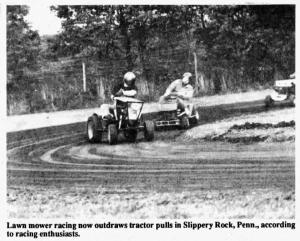1989 - Volume #13, Issue #1, Page #20
[ Sample Stories From This Issue | List of All Stories In This Issue | Print this story
| Read this issue]
Lawn Mower Racing Catching On Fast
 |
5 mph but you can race riding mowers at speeds of 35 to 40 mph, according to Jack Boyer, one of a group of men and women who race riding lawn mowers on an oval dirt track just outside Slippery Rock, Penn.
Boyer has been racing riding lawn mowers for the past five years. He drives a modified 1966 Sears & Roebuck "Suburban", boosting its speed by changing the gearing and pulley sizes.
Most racers use "junked out" riding lawn mowers which they modify and paint. "It's the poor man's Indy 500 and the closest I'll ever come to racing stock cars," says Boyer. "A stock car engine can cost $10,000 and one season's racing requires thousands of dollars in upkeep. On the other hand, you can modify and paint a riding lawn mower for $500 or less."
Lawn mower racing was born at Cooper's Lake Raceway near Slippery Rock, which is about 60 miles north of Pittsburgh. The races began as a challenge in 1981 when two men who met at a Slippery Rock gas station argued over whose lawn mower was faster. They settled the bet with a dash across an open field. That event evolved into full-blown races with time trials, heats and feature races, as well a comprehensive set of rules and regulations.
Races are held every other weekend from May through September in conjunction with fairs and local farm shows. They're divided into threes classes: 8 hp stock, 8 hp modified and 10 to 12 hp modified. There are also `powder puff" races for women. Normally,
6 to 8 riders participate in each race. Spectators pay $2 to watch and the races have become a big hit around Slippery Rock, even outdrawing tractor pulls at local farm shows. "The crowds just love it," says Boyer. "They're amazed that an 11-hp riding mower can scoot around a 1/10 mile oval track like a sports car, with rooster tails flying and tires digging into the dirt."
Drivers pay a $10 entry fee to cover maintenance and insurance. There's no prize money, but winners get trophies topped with miniature garden tractors. "It's a good of time on Saturday night and we have lots of laughs. But all the drivers are serious about wanting the checkered flag," says Boyer, who has won several trophies.
According to the rules, bumpers and side rub rails are required to keep the mowers from tangling *with each other. Head-lights must be removed. Helmets and boots are required.
Garden tractors aren't allowed because at 14 to 20 ' hp they're more powerful than riding lawn. mowers which normally have a maximum of 12 hp. "We don't allow modification of the engine or tires," notes Boyer. "Racing on normal riding lawn mower tires makes the mower slide sideways when going around corners at 30 mph. The crowds love to see the waves of dirt spraying from the rear wheels."
There's a real art to making an 11-hp riding lawn mower stay on the track at high speeds. "We use some of the same principles used by stock car drivers," says Boyer. He equipped the front of his riding mower with motorcycle shocks to help keep the mower from tipping over on corners and installed heavy duty bushings and bearings on the mower's trans-axle rear end because it turns five times faster than normal. Mower speed is increased by changing gears and pulleys.
Junked out" riding mowers are becoming scarce in Butler County, but Boyer says potential lawn mower racers in other parts of the country should have no trouble finding old mowers. "You'd be surprised how many people keep junked out mowers in their yards or behind the barn. All you have to do is rebuild the motor, make a few modifications, paint the body, put a number on, and you're ready to go."
The safety record of the new sport has been good. "We've had some accidents, but no one has been seriously hurt," says Boyer.
For more information, contact: FARM SHOW Followup, Jack Boyer, R.D. 3, Box 399N, Slippery Rock, Penn. 16057 (ph 412 794-6566).

Click here to download page story appeared in.

Click here to read entire issue
To read the rest of this story, download this issue below or click here to register with your account number.




